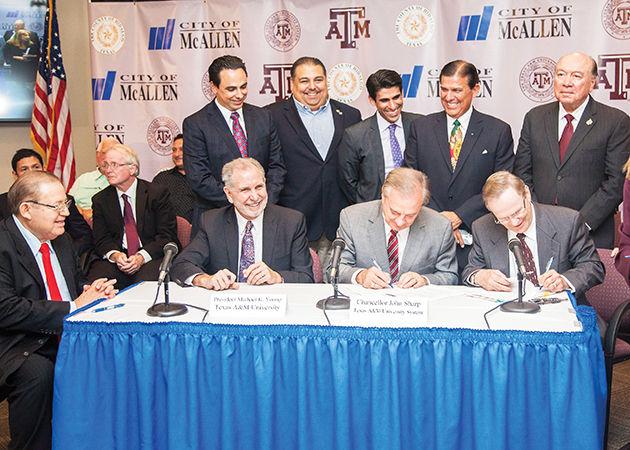University officials announced the new campus in McAllen with hopes of bringing higher education to an area of Texas with few options.
Shane Hinckley, A&M university spokesperson, said the endeavor will start out on a small scale in 2017 with a focus on teaching and learning, but has the potential to grow.
“We anticipate opening with about 100 students and expanding to approximately 750 by 2022,” Hinckley said.
The new campus will be similar to A&M-Galveston, acting as a direct extension of the flagship campus and granting students a Texas A&M diploma and an Aggie Ring, said Chancellor John Sharp in an article with The Monitor. According to the article, Sharp said the new campus will allow students who live closer to the Valley area to take classes in McAllen and receive their diploma in College Station.
Melanie Garza, president of the Council for Minority Student Affairs, said students from the area who want to be Aggies but do not want to go to the College Station campus because of distance will benefit from this opportunity.
“I’m so glad this is being established because I have seen so many people cut their dreams short because of the seven-hour gap between family and school,” Garza said.
Leslie Botello, a political science senior from the Valley, said it is typically considered one of the less-educated areas of the country, and this new campus would allow it the opportunity to become better.
“It will allow students to obtain an education from a world-class university and hopefully help McAllen come off the list of least educated cities in America,” Botello said.
Roy Rodriguez, city manager of McAllen, said the facility gives local residents the opportunity to get a higher education.
“The Rio Grande Valley is home to 1 million people and another 1 million people on the other side of the Texas-Mexico border,” Rodriguez said. “The question should have been asked long ago — why isn’t there another university in the RGV?”
The idea for the facility had been discussed years ago but never received traction until recently, said Rodriguez.
“We have been working on this for the last 18 months or so,” Rodriguez said.
Rodriguez said the facility is a long-term project that will only move forward with proper planning and funding.
“I believe it will transform the educational landscape in the next 25 years,” Rodriguez said.
Hinkley said the campus would be an opportunity to serve a growing region with Texas A&M’s unique land-grant approach to education.
“A major component of the land-grant mission is to provide service and support at the grassroots level and make that service and support readily available — we have a long history of serving first-generation students,” Hinckley said. “Each year, approximately 25 percent of our freshmen are first-generation college students.”
James Palacios, agricultural communications and journalism junior from the Valley, said with the addition of the new Texas A&M facility, the educational opportunities offered in the Valley would become limitless. Palacios said he would like to see the facility offer classes and college credit to high school students like other colleges in the area.
“I think this will be extremely successful especially with several school districts leading the way nationally in early-college high schools and concurrent enrolment and dual credit programs,” Palacios said.
Kassandra Gonzalez, biomedical science freshman from the Valley, said although the campus sounds like a good idea, she does not think it would benefit the Valley to build a new satellite campus. Gonzalez said she is worried students who stay in the Valley will miss out on experiences they can only receive by moving away for a few years.
“This change was not only due to the higher level of education that they were receiving, but because of the diverse exposure that the Rio Grande Valley fails to offer,” Gonzalez said. “I felt like this will hurt students who would have someday had the possibility of leaving the Rio Grande Valley.”
Adriana Zarate, sophomore university studies from the Valley, said this campus could help people with financial restrictions receive an education from Texas A&M without having to leave the Rio Grande Valley.
“It will affect the Valley’s education in a positive way because I know of several students that would have loved to have attended Texas A&M College Station but couldn’t due to financial reasons,” Zarate said.










